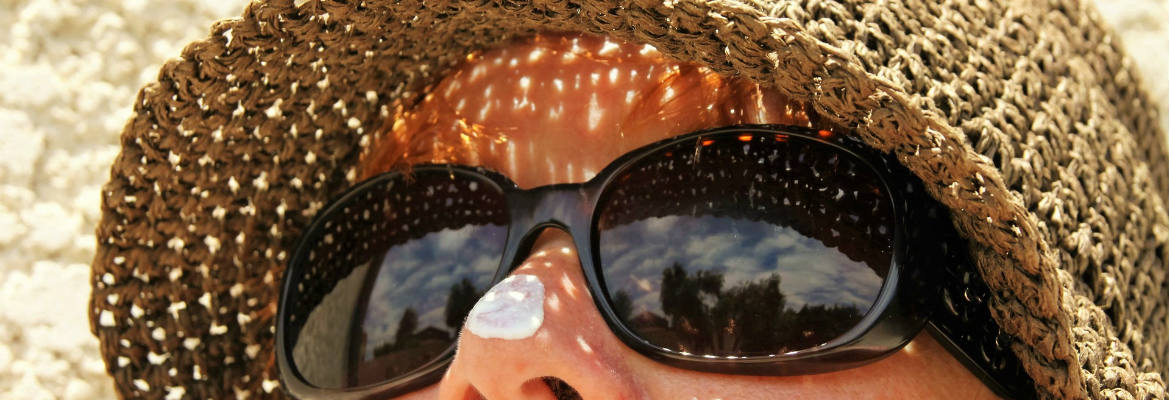“I like a tanned look. I don’t overdo it like some of my friends. And sunlight’s good for you … isn’t it?”
Did you know the sun not only can cause you to develop a sunburn, induce aging, cause skin sensitivity and cancer formation, but it can also promote immunosuppression! A sunscreen should protect you from all these things. [1]
According to the American Academy of Dermatology, there are three things that your sunscreen should do:
- Sunscreen should protect against both UVA and UVB rays,
- Sunscreen should have a sun protection factor (SPF) of at least 30 but not over 45,
- Sunscreen should be labeled “water-resistant.” [2]
If you’re outside for prolonged periods or running in and out of buildings several times a day without protection, damage may be happening in the skin. Low dose repetitive UVB exposure can cause skin cancer.
So we wear sunscreen to guard against that. Skin cancer is typically divided into two categories: nonmelanoma and melanoma. The most common type of nonmelanoma skin cancer is Basal Cell Carcinoma (BCC) followed by Squamous Cell Carcinoma (SCC).
Sunscreens do prevent SCC, according to many human studies. Their ability to provide prevention of BCC and melanoma is less substantiated, although there is some evidence that supports this. A study looked at the effects of SPF 17 sunscreen on 588 individuals during one Australian summer and found a significant reduction in the number of pre-cancers called actinic keratoses compared with the placebo group. [1]
According to the Skin Cancer Foundation:
- Each year in the U.S. over 5.4 million cases of nonmelanoma skin cancer are treated in more than 3.3 million people.
- Each year there are more new cases of skin cancer than the combined incidences of cancers of the breast, prostate, lung and colon.
- Over the past three decades, more people have had skin cancer than all other cancers combined.
- One in five Americans will develop skin cancer in the course of a lifetime.
- Between 40 and 50 percent of Americans who live to age 65 will have either basal cell carcinoma or squamous cell carcinoma at least once.
- Basal cell carcinoma (BCC) is the most common form of skin cancer. [3] More than 4 million cases are diagnosed in the U.S. each year.
- Squamous cell carcinoma is the second most common form of skin cancer. [4] More than 1 million cases are diagnosed in the U.S. each year.
- Organ transplant patients are approximately 100 times more likely than the general public to develop squamous cell carcinoma.
- Actinic keratosis is the most common precancer; it affects more than 58 million Americans.
- About 90 percent of nonmelanoma skin cancers are associated with exposure to ultraviolet (UV) radiation from the sun.
- The annual cost of treating skin cancers in the U.S. is estimated at $8.1 billion: about $4.8 billion for nonmelanoma skin cancers and $3.3 billion for melanoma.
What are the risks associated with melanoma?
- One person dies of melanoma every hour (every 54 minutes).
- On average, a person’s risk for melanoma doubles if he or she has had more than five sunburns.
- An estimated 87,110 new cases of invasive melanoma will be diagnosed in the U.S. in 2017.
- An estimated 9,730 people will die of melanoma in 2017.
- Melanoma accounts for less than one percent of skin cancer cases, but the vast majority of skin cancer deaths.
- The vast majority of melanomas are caused by the sun. In fact, one UK study found that about 86 percent of melanomas can be attributed to exposure to ultraviolet (UV) radiation from the sun.
- The estimated 5-year survival rate for patients whose melanoma is detected early is about 98 percent in the U.S. The survival rate falls to 62 percent when the disease reaches the lymph nodes, and 18 percent when the disease metastasizes to distant organs.
Regular daily use of sunscreen (we recommend SPF between 30 and 45) reduces the risk of developing squamous cell carcinoma by about 40 percent and the risk of developing melanoma by 50 percent. [3]
- Bolognia, J., Jorizzo, J.L., & Schaffer, J.V. (2012). Dermatology (3rd ed) (pp. 1892, 2197, 2198, 2201). Philadelphia: Elsevier Saunders.
- Neider, Sara. (2014). Journal of the Dermatology Nurses’ Association, 6(2), 72-73.
- Skin Cancer Facts & Statistics (2017). Skin Cancer Foundation. Retrieved April 6, 2017 from skincancer.org/skin-cancer-information/skin-cancer-facts
- Slip, Slop, Slap, Seek & Slide: Sid Seagull. (n.d). Retrieved April 9, 2017 from www.sunsmart.com.au/tools/videos/current-tv-campaigns/slip-slop-slap-seek-slide-sid-seagull.html

